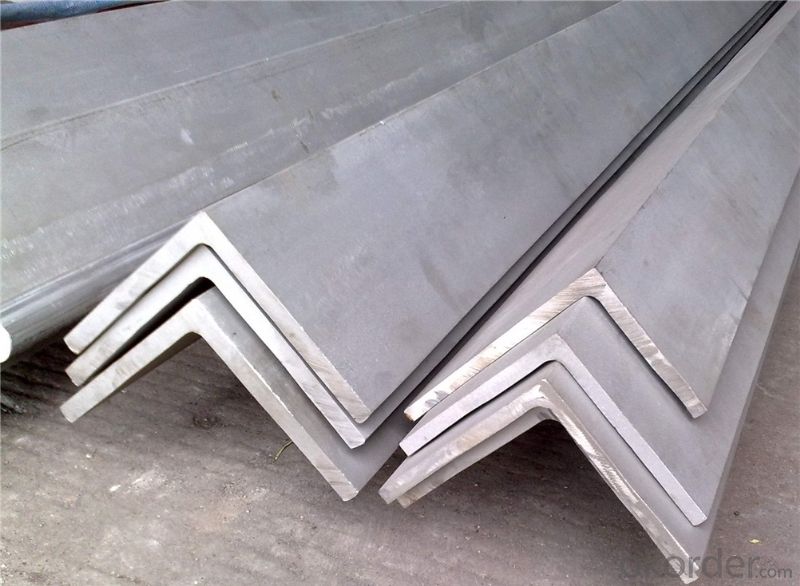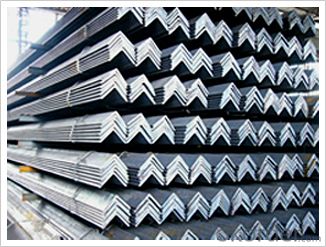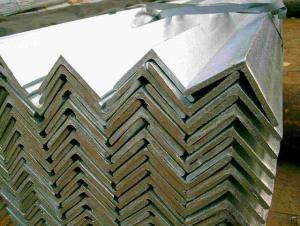20mm*2.5mm hot sell Equal Angle for construction
- Loading Port:
- Tianjin
- Payment Terms:
- TT OR LC
- Min Order Qty:
- 25 m.t.
- Supply Capability:
- 10000 m.t./month
OKorder Service Pledge
OKorder Financial Service
You Might Also Like
Product Description:
1.Grade: SS200,300,400 series
2.Size: 25×25×3 mm-100×100×10mm
3.Process: HRAP
4. Length: 2-6m
5. Shape: Equal
6. Delivery: within 20 days
7. MOQ: 1 ton
8. Certificate: ISO 9001:2008, SGS
9. Package:Standard Export Packing, or put into wooden boxes according to your requirement
10. Application: Construction, Marine, Industry and so on
Name | Stainless Steel Angles | ||||||
Standard | ASTM A554, A312, A249, A269 and A270 | ||||||
Material Grade | 304,316,201,202, 316L,430 | ||||||
Length | 6m or as customers' request | ||||||
Tolerance | a) thickness: +/-0. 15mm | ||||||
b) Length:+/-4. 5mm - 0mm | |||||||
Surface | 180G, 320G, 400G Satin / Hairline(Matt Finish, Brush, Dull Finish) 400G, 500G, 600G or 800G Mirror finish | ||||||
Application | Decoration construction, upholstery, industry instruments | ||||||
Test | Squash test, Extended test, Water pressure test, Crystal rot test, Heat treatment, NDT | ||||||
Chemical Composition of Material |
Composition
Material | 201 | 202 | 304 | 316L | 430 | |
C | ≤0.15 | ≤0.15 | ≤0.08 | ≤0.08 | ≤0.12 | ||
Si | ≤1.00 | ≤1.00 | ≤1.00 | ≤1.00 | ≤1.00 | ||
Mn | 5.5-7.5 | 7.5-10 | ≤2.00 | ≤2.00 | ≤1.00 | ||
P | ≤0.06 | ≤0.06 | ≤0.045 | ≤0.045 | ≤0.040 | ||
S | ≤0.03 | ≤0.03 | ≤0.030 | ≤0.030 | ≤0.030 | ||
Cr | 16-18 | 17-19 | 18-20 | 16-18 | 16-18 | ||
Ni | 3.5-5.5 | 4-6 | 8-10.5 | 10-14 | |||
Mo | 2.0-3.0 | ||||||
Mechanical Property | Material Item | 201 | 202 | 304 | 316L | ||
Tensile Strength | ≥535 | ≥520 | ≥520 | ≥520 | |||
Yield Strength | ≥245 | ≥205 | ≥205 | ≥205 | |||
Extension | ≥30% | ≥30% | ≥35% | ≥35% | |||
Hardness (HV) | <253 | <253 | <200 | <200 | |||
Usage & Applications of Angle Steel
According to the needs of different structures, Angle can compose to different force support component, and also can be the connections between components. It is widely used in various building structures and engineering structures such as roof beams, bridges, transmission towers, hoisting machinery and transport machinery, ships, industrial furnaces, reaction tower, container frame and warehouse etc.
Packaging & Delivery of Angle Steel
1. Packing: it is nude packed in bundles by steel wire rod
2. Bundle weight: not more than 3.5MT for bulk vessel; less than 3 MT for container load
3. Marks:
Color marking: There will be color marking on both end of the bundle for the cargo delivered by bulk vessel. That makes it easily to distinguish at the destination port.
Tag mark: there will be tag mark tied up on the bundles. The information usually including supplier logo and name, product name, made in China, shipping marks and other information request by the customer.
If loading by container the marking is not needed, but we will prepare it as customer request.
Production flow of Angle Steel
Material prepare (billet) —heat up—rough rolling—precision rolling—cooling—packing—storage and transportation



- Q:Can steel angles be used in the construction of pedestrian bridges?
- Yes, steel angles can be used in the construction of pedestrian bridges. Steel angles are a commonly used structural element in construction due to their strength, durability, and ability to support heavy loads. They provide stability and structural integrity to the bridge, making them suitable for constructing pedestrian bridges.
- Q:How do you calculate the moment of resistance for a steel angle?
- When calculating the moment of resistance for a steel angle, one must take into account the properties of the angle section and its dimensions. The moment of resistance measures the angle's ability to resist bending. The moment of resistance can be calculated using the formula: Moment of Resistance = Plastic Section Modulus multiplied by Yield Strength of Steel The plastic section modulus can be determined using the following formula: Plastic Section Modulus = (Width multiplied by Thickness squared) divided by 6 In this equation, the width refers to the distance between the outer edges of the angle, while the thickness refers to the thickness of the angle section. The yield strength of the steel is a material property that can be obtained from its specification or reference material. It represents the maximum stress the steel can endure without experiencing permanent deformation. By substituting the values of the plastic section modulus and the yield strength of the steel into the formula for the moment of resistance, one can calculate the value. It is important to note that the dimensions used in the calculations should be in consistent units, such as millimeters or inches, depending on the units used for the yield strength value. This calculation provides an estimation of the moment of resistance for a steel angle and is valuable in structural engineering applications for determining the angle section's capacity under bending loads.
- Q:What is the purpose of using steel angles in construction?
- Steel angles serve various purposes in construction. Their primary function is to offer structural support and stability to different components of a building or structure. Reinforcing corners, edges, and joints, these angles enhance the overall strength and rigidity of the structure. Moreover, steel angles play a crucial role in distributing and transferring loads or forces within the construction. They facilitate the even distribution of weight and stress across various parts of the structure, preventing the formation of weak points. Furthermore, steel angles are highly versatile and can be easily customized and fabricated to meet specific construction requirements. They can be cut, drilled, and welded, seamlessly integrating into a wide range of construction projects. Not only that, but steel angles also exhibit remarkable durability and resistance to corrosion, making them suitable for both indoor and outdoor applications. With the ability to withstand heavy loads and extreme weather conditions, they provide long-lasting support to the structure. In conclusion, the utilization of steel angles in construction aims to enhance structural integrity, provide support and stability, distribute loads, and ensure the longevity of the building or structure.
- Q:What are the common methods of surface preparation for steel angles?
- The common methods of surface preparation for steel angles include grinding, sandblasting, and chemical cleaning. Grinding is a mechanical method where the surface of the steel angle is smoothed and leveled using an abrasive wheel or disc. This method is effective in removing rust, scale, and other surface imperfections. It is commonly used for small-scale projects or when a smooth surface finish is not critical. Sandblasting, also known as abrasive blasting, involves propelling small particles at high speeds onto the surface of the steel angle. This method is highly effective in removing mill scale, rust, paint, and other contaminants. Sandblasting provides a roughened surface that promotes better adhesion of coatings or paints. It is commonly used in large-scale industrial projects where a high-quality surface finish is required. Chemical cleaning involves using chemical solutions to remove contaminants from the surface of the steel angle. This method is effective in removing rust, oil, grease, and other organic materials. Chemical cleaning can be done through various techniques such as immersion or brush application. It is commonly used when sandblasting or grinding may not be feasible or practical. In addition to these methods, other surface preparation techniques may include power tool cleaning, flame cleaning, or a combination of methods depending on the specific requirements of the project. It is important to choose the appropriate method based on the condition of the steel angle, the desired surface finish, and the intended application of the steel angle.
- Q:How do you handle and install steel angles on a construction site?
- Handling and installing steel angles on a construction site requires careful planning and attention to detail. Here are the steps involved in handling and installing steel angles: 1. Preparing the site: Before handling steel angles, it is essential to ensure that the construction site is properly prepared. This includes clearing any debris or obstructions, ensuring a stable and level surface, and taking necessary safety precautions. 2. Measuring and marking: Accurate measurements of the steel angles' dimensions and their placement on the construction site are crucial. Using a measuring tape, determine the length, width, and thickness of the steel angles, and mark their intended locations on the site. This will ensure proper alignment and fit during the installation process. 3. Handling and transporting: Steel angles can be heavy, so it is important to use appropriate lifting equipment such as cranes, hoists, or forklifts to handle and transport them safely. Ensure that the lifting equipment is properly rated and operated by trained personnel to prevent accidents or damage to the steel angles. 4. Securing the steel angles: Once the steel angles are properly positioned, secure them in place using appropriate fasteners such as bolts, screws, or welding. The choice of fasteners depends on the specific requirements of the construction project and the load-bearing capacity of the steel angles. Make sure to follow the manufacturer's guidelines and industry standards for fastener selection and installation. 5. Checking alignment and levelness: After securing the steel angles, use a level and measuring tools to check their alignment and levelness. This step is crucial to ensure that the steel angles are installed correctly and will provide the necessary structural support. 6. Inspecting and reinforcing: Conduct a thorough inspection of the installed steel angles to ensure that they are free from any defects or damages. If any issues are identified, take appropriate measures to reinforce or replace the steel angles to maintain the structural integrity of the construction site. 7. Ongoing maintenance: Steel angles, like any other construction materials, require regular maintenance to extend their lifespan and prevent corrosion. Follow the manufacturer's recommendations for maintenance and periodically inspect the steel angles to identify and address any issues promptly. Overall, handling and installing steel angles on a construction site require careful planning, proper equipment, and adherence to safety guidelines. By following these steps, construction professionals can ensure the successful installation of steel angles, contributing to the overall strength and stability of the structure.
- Q:What are the different types of connections used with steel angles?
- There are several types of connections commonly used with steel angles, including bolted connections, welded connections, and clip connections. Bolted connections involve using bolts and nuts to fasten the angles together, while welded connections involve fusing the angles together using heat. Clip connections, on the other hand, involve using clips or brackets to connect the steel angles. Each type of connection has its own advantages and is used depending on the specific requirements and design considerations of the steel structure.
- Q:What are the different types of corrosion that can affect steel angles?
- There are several different types of corrosion that can affect steel angles, including general corrosion, pitting corrosion, crevice corrosion, galvanic corrosion, and stress corrosion cracking.
- Q:Can steel angles be used in the construction of shopping malls?
- Yes, steel angles can be used in the construction of shopping malls. Steel angles are versatile structural components that can provide support and stability to various elements of a building, including shopping malls. They are commonly used in the construction industry for framing, bracing, and reinforcing structures. Steel angles can be used to support the walls, roof, and floors of shopping malls, ensuring the structural integrity of the building. Additionally, they can be used in the construction of staircases, escalators, and mezzanines within the shopping mall. The use of steel angles in shopping mall construction offers several advantages, including their durability, strength, and cost-effectiveness.
- Q:Can steel angles be used for machinery frames?
- Yes, steel angles can be used for machinery frames. Steel angles are commonly used in construction and manufacturing industries due to their strength and versatility. They are often used to provide structural support and stability in various applications, including machinery frames. Steel angles offer a cost-effective solution as they are readily available and can be easily fabricated to meet specific design requirements. Additionally, steel angles provide excellent load-bearing capacity and resistance to deformation, making them suitable for supporting heavy machinery and equipment. Their rigid and durable nature ensures the stability and longevity of machinery frames, making them a reliable choice in industrial settings.
- Q:What are the different shapes available for steel angles?
- Steel angles come in various shapes, each serving a specific purpose in construction and structural applications. The most common shapes include the following: 1. Equal angles: These angles have legs of equal length and are formed by bending a single piece of steel. They find common use in general structural applications, such as supporting beams and columns. 2. Unequal angles: As the name suggests, these angles have legs of unequal length. They are often employed when one leg needs to be longer or shorter than the other. In construction, they provide additional strength and support in various applications. 3. L-shaped angles: These angles have one leg longer than the other, creating an L-shape. They are frequently used to reinforce corners and edges of structures, offering extra strength and support. 4. T-shaped angles: These angles have a longer leg that extends perpendicular to a shorter leg, forming a T-shape. They are commonly utilized as lintels or beams to support loads above openings like doors and windows. 5. C-shaped angles: These angles have one side curved inward, resulting in a C-shape. They are often employed in situations where the angle needs to fit around a curved or rounded surface, providing structural support and reinforcement. In summary, the availability of various steel angle shapes enables a wide range of applications in construction and structural engineering. They offer strength, support, and versatility in numerous projects.
1. Manufacturer Overview |
|
|---|---|
| Location | |
| Year Established | |
| Annual Output Value | |
| Main Markets | |
| Company Certifications | |
2. Manufacturer Certificates |
|
|---|---|
| a) Certification Name | |
| Range | |
| Reference | |
| Validity Period | |
3. Manufacturer Capability |
|
|---|---|
| a)Trade Capacity | |
| Nearest Port | |
| Export Percentage | |
| No.of Employees in Trade Department | |
| Language Spoken: | |
| b)Factory Information | |
| Factory Size: | |
| No. of Production Lines | |
| Contract Manufacturing | |
| Product Price Range | |
Send your message to us
20mm*2.5mm hot sell Equal Angle for construction
- Loading Port:
- Tianjin
- Payment Terms:
- TT OR LC
- Min Order Qty:
- 25 m.t.
- Supply Capability:
- 10000 m.t./month
OKorder Service Pledge
OKorder Financial Service
Similar products
New products
Hot products
Related keywords




























